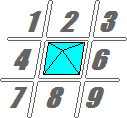
An Icehouse Pyramid Game
Abstract strategy for three or more players
by Geoff Hanna

- One differently-colored tube/stash of Icehouse pyramids per player plus two other colors (rules assume Black and White)
- A flat surface
- One bowl, bag or box to contain pyramids – “The Pool”
- One coin or other object – the “Turn Token”
Players alternate playing out of their hand by placing a pyramid into a temporary common structure (the Yard), following size and color rules. The Yard will continue to grow during the hand.
The hand continues until all players pass their turn. The last player to add to the Yard wins the hand.
The hand winner takes all of the pyramids from the Yard and adds them into the Ice Palace (a second, permanent common structure that will grow throughout the game), following a reversed set of size and color rules.
Players replenish their hands by blindly drawing from the Pool until they again have two pyramids of each size.
When a player cannot replenish their hand from the Pool, the Ice Palace is scored: each stack with one color on top earns points for that player, one point for each pyramid in the stack. Highest score is the winner.

A three-player game already in progress

Once players are seated, randomly draw one pyramid from the pool to determine the first player (redraw on Black or White). The first player receives the “Turn Token”. Replace the drawn pyramid into the pool.
Each player randomly draws three more pyramids, one of each size, to complete their starting hand.
Moving around the group clockwise, each player must choose whether to Pass, or Play a pyramid into the Yard.
- Any color pyramid may be added to a stack if it is bigger than the current top pyramid (nothing can stack over a Large pyramid)
- You can start a new stack adjacent to any existing stack as long as the pyramids are the same color
- Black is Null and matches no colors, not even itself. White is Wild and matches all colors except Black

|
|
A Cyan pyramid could play in imaginary grid squares 2, 4, 6 and 8: 1, 3, 7 and 9 are not adjacent |
The Yard and Ice Palace are both built using imaginary grids that stretch to infinity in all directions. An “adjacent” pyramid is laid next to an existing pyramid, side-by-side, as shown in the illustration to the right.
Passing
You may choose to pass at any time. Exception: players that have no possible legal placement must pass.
Passing during one go-round of the hand does not prevent you from playing in future rounds of the hand.
Negotiating
Players may not trade pyramids. Eveything else - whether to pass or play, what pyramid to play, where to play it, how to build the Ice Palace - is open to negotiation
All of the other pyramids are built into the Ice Palace, one at a time, according to the Ice Palace building code:
- Only smaller pyramids can be stacked onto an existing pyramid and nothing can stack over a Small pyramid
- You can start a new stack adjacent to any existing stack as long as the new pyramids is the same color as the adjacent top pyramid (this is essentially the same as the Yard code)
It is possible that the builder cannot satisfy Ice Palace building codes and also use up the entire Yard. The builder must use the maximum possible pyramids - everyone must agree to the maximum possible number - and the builder still decides exactly how to reach that number. Unusable pyramids are discarded and removed from play.
The Turn Token passes one player clockwise.

|
| If this were a portion of the Ice Palace, Green would score 4, Yellow 2, and Cyan would get nothing |
Each player determines their score by totalling the number of pyramids in the Ice Palace that have their own color as the top pyramid in a stack.
Ice Palace (C) 2004 Geoff Hanna
